There are many different bird species to see in New Jersey, and ducks are an easy category of birds to overlook. But many ducks can be seen in New Jersey – perhaps more than you might think.
Here is a list of some of the species you may encounter when birdwatching in this state, along with details of when you might see each one:
Mallard
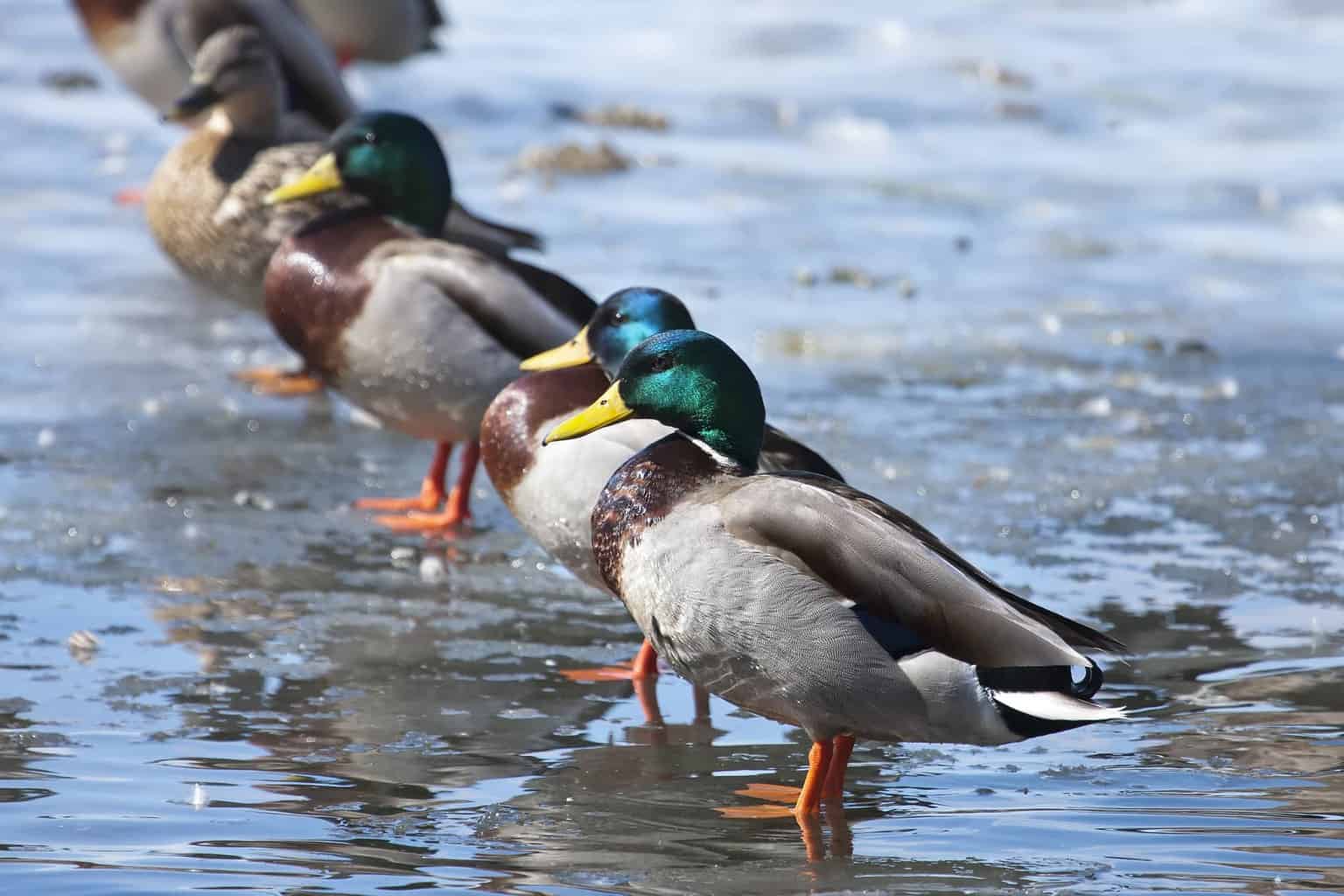
- Anas platyrhynchos
- Length: 19.7 – 25.6 in (50 – 65 cm)
- Weight: 35.3 – 45.9 oz (1000 – 1300 g)
- Wingspan: 32.3 – 37.4 in (82 – 95 cm)
As in many states, mallards are one of the most common duck species to be seen in New Jersey. They can be seen here throughout the year and are almost equally commonly seen in the summer and winter months.
There are ducks that you may well be used to feeding on ponds or rivers, or in city parks. They are dabbling ducks that feed on water plants.
The adult males are instantly recognizable with their bright green beads, yellow bills, and blue wing patches. Female mallards and young birds are mottled brown with orange bills but also have blue wing patches.
American Black Ducks
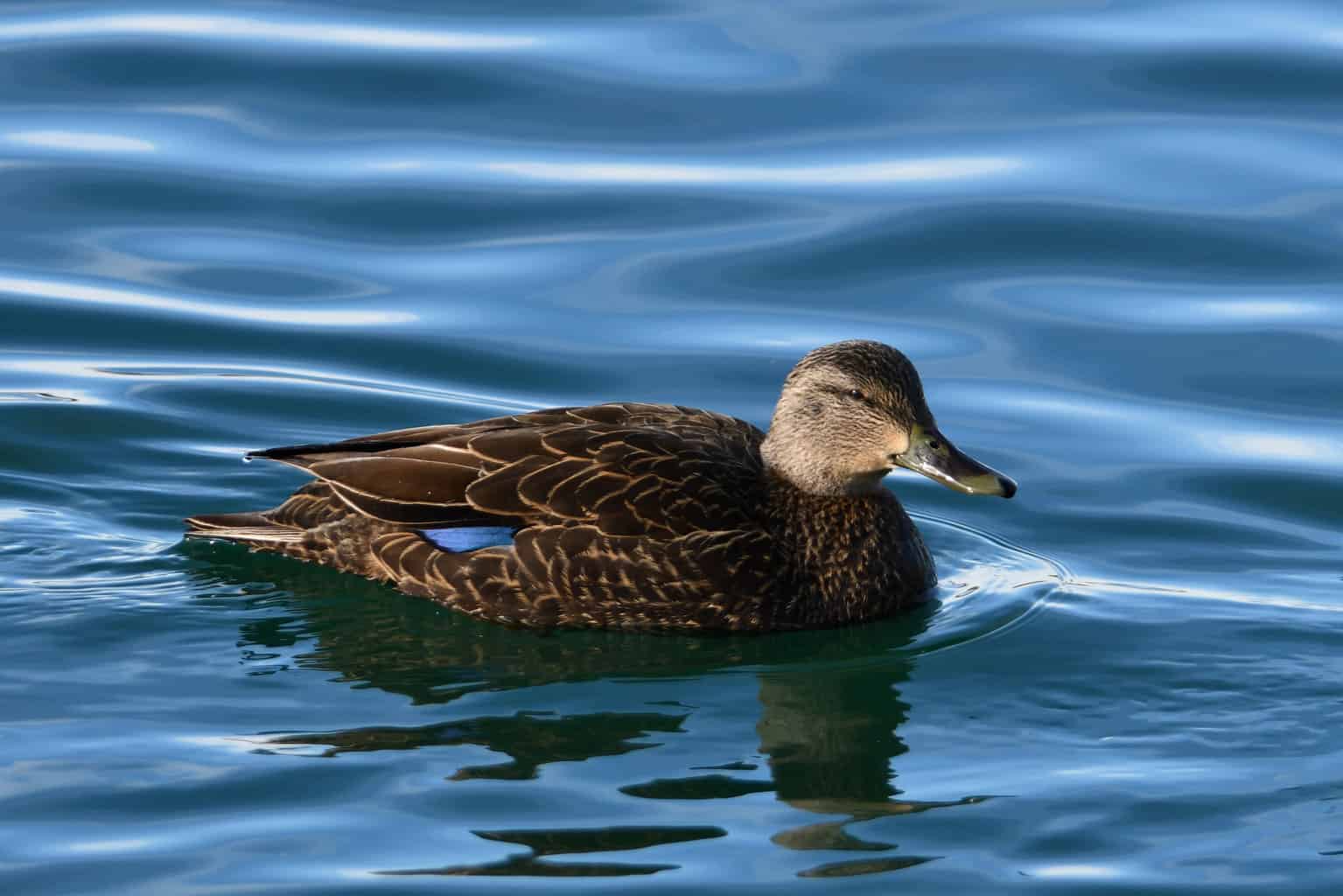
- Anas rubripes
- Length: 19 – 23 in (48 – 58 cm)
- Weight: 49.6 oz (1406 g)
- Wingspan: 33 – 36 in (84 – 91 cm)
This is another duck species that you can see in New Jersey throughout the year. Though you are more likely to see them through the winter months, between October and March.
You can encounter American black ducks in a range of different environments, from salt marshes, estuaries, inland lakes, and ponds, to wet woodland and farm fields. They forage on both land and water.
These large, heavy dabbling ducks have dark brown bodies and paler brown heads. Males have yellow bills and females have olive ones. Both genders have blue-purple wing patches and orangey-red legs.
Wood Ducks
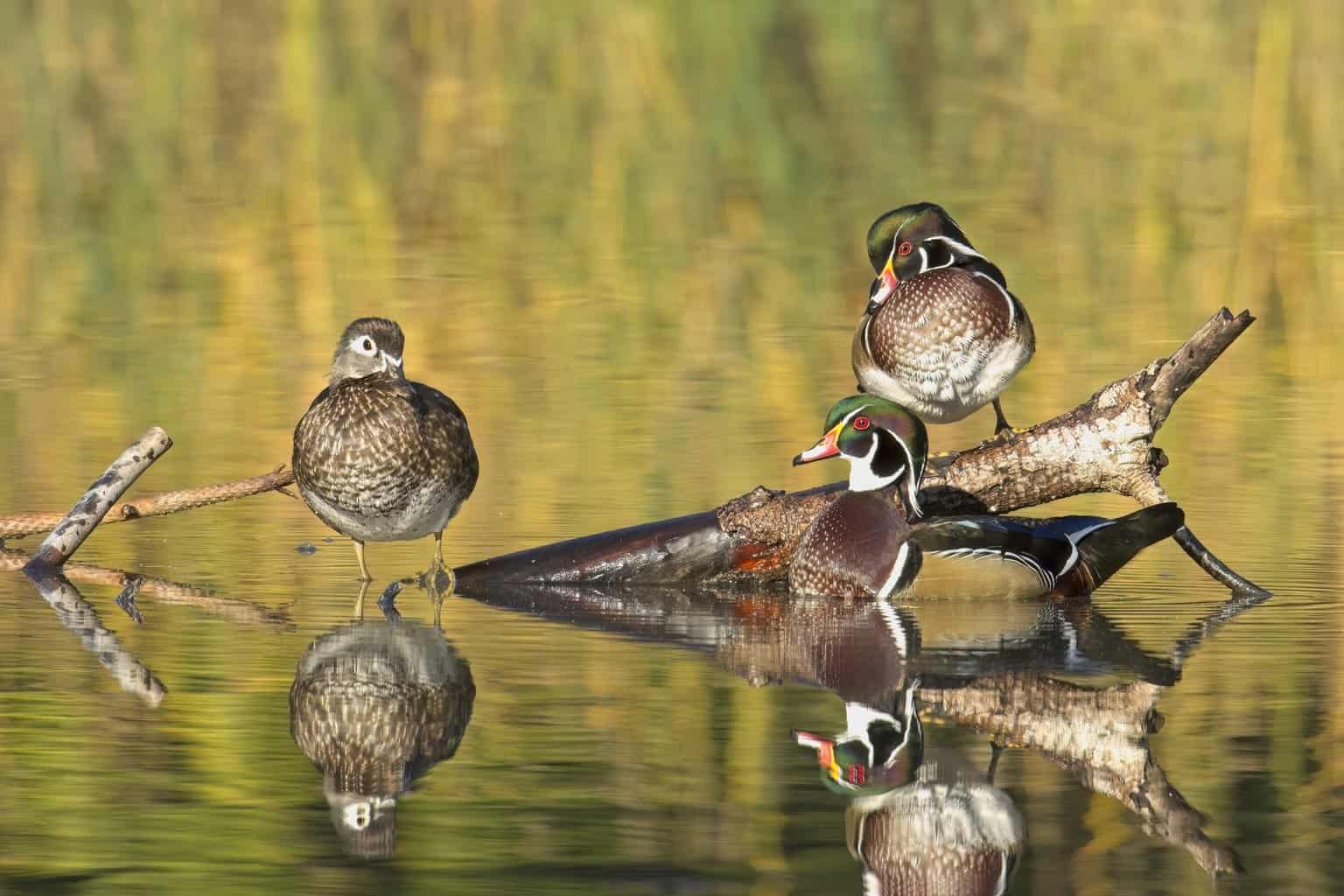
- Aix sponsa
- Length: 18.5 – 21.3 in (47 – 54 cm)
- Weight: 16.0 – 30.4 oz (454 – 862 g)
- Wingspan: 26.0 – 28.7 in (66 – 73 cm)
These ducks can also be seen in New Jersey all year long. But they are most commonly seen here in this state between March and November.
You will most commonly encounter wood ducks, as the name suggests, in wet wooded areas, where they feed both in the water and on land, in fields and woodlands, or in areas dense with trees.
The males have green heads with striking crests, black and white markings, and red eyes. Females are brown, with white around their dark eyes. Both males and females have blue patches on their wings.
Gadwalls
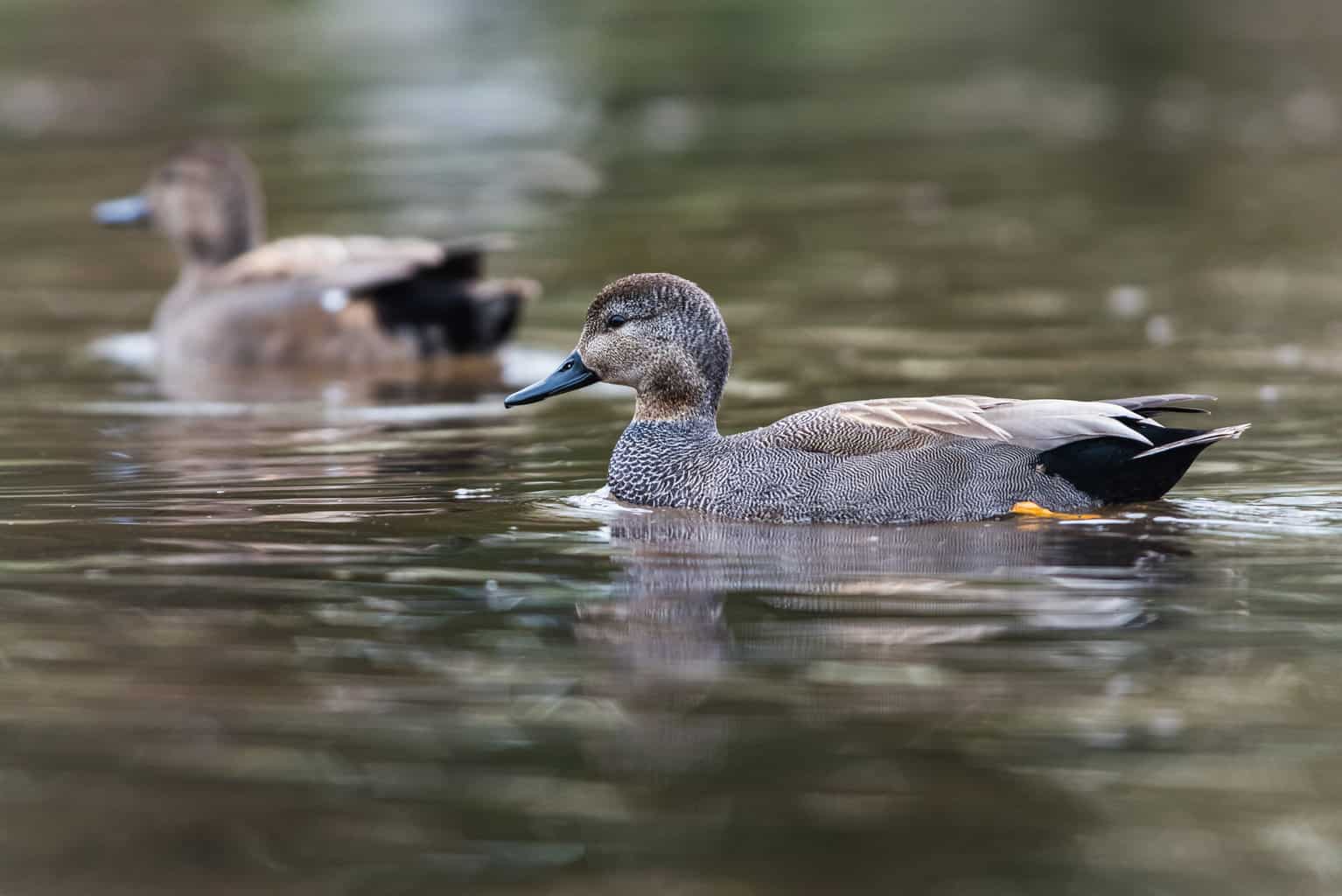
- Mareca strepera
- Length: 19 – 23 in (48 – 58 cm)
- Weight: 35.27 oz (1000 g)
- Wingspan: 31 – 36 in (79 – 91 cm)
Some gadwalls reside in New Jersey year-round. But most sightings of this duck occur during the winter months, since many of these ducks arrive in October, and depart again in March.
Look out for these ducks in city parks, saltwater marshes, muddy estuaries, and reservoirs, which are habitats that they tend to frequent in winter.
These large dabbling ducks have subtle plumage. Males have darker brown heads, black patterns on their chests and shoulder, white bellies, and black bottoms. Females have more diffuse scale patterns and are generally brown in hue.
Green-Winged Teal
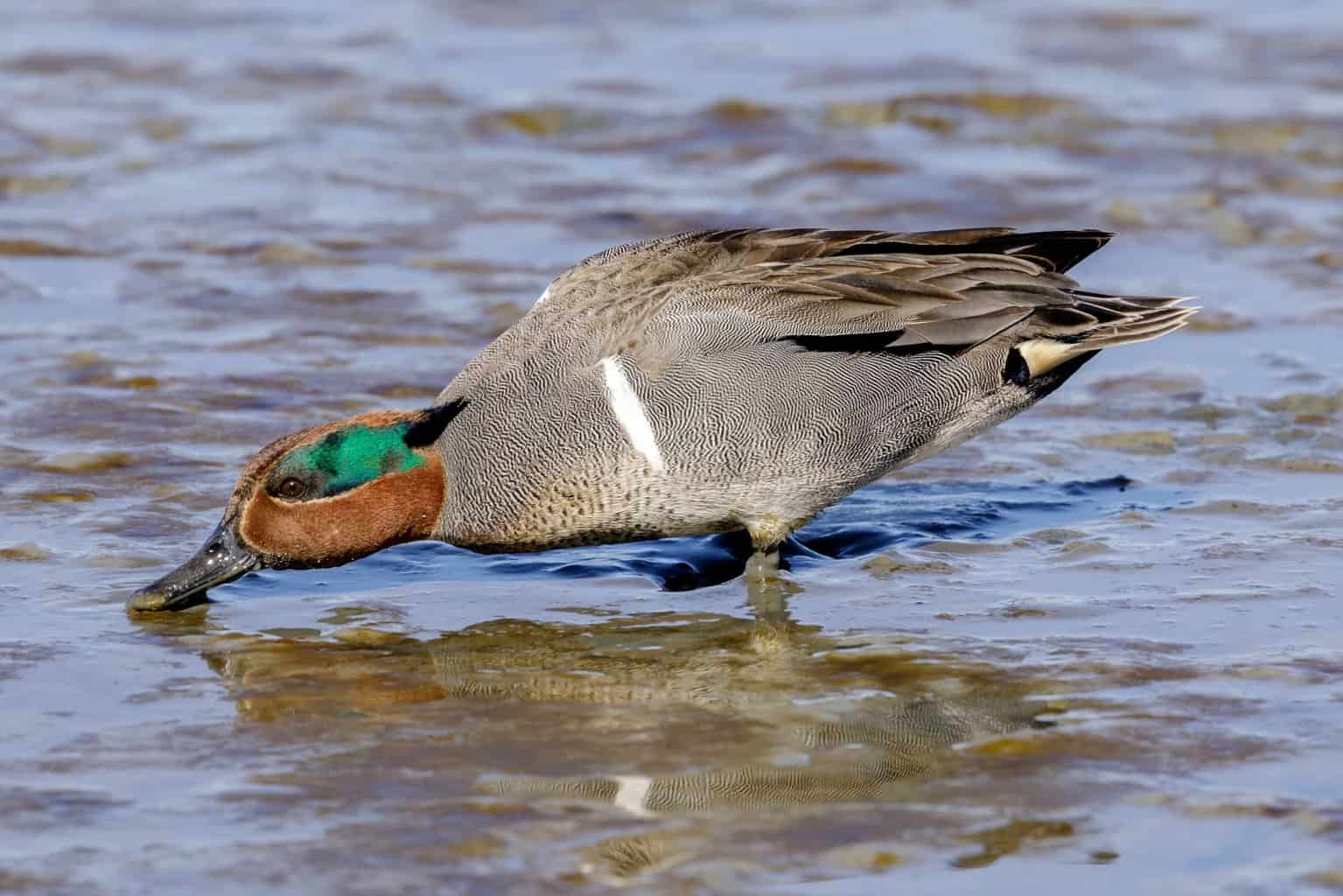
- Anas crecca
- Length: 12.2 – 15.3 in (31 – 39 cm)
- Weight: 4.9 – 17.6 oz (140 – 500 g)
- Wingspan: 20.5 – 23.2 in (52 – 59 cm)
This is another duck that has been seen here in New Jersey year-round. However, most sightings occur between March and April, and again from October to November, during the key periods of migration.
These small dabbling ducks can be seen in boggy, flooded areas and shallow ponds in large groups. They eat invertebrates and also seeds and make their nests in grass or ground thickets.
The males have green stripes along the sides of their heads, otherwise brown heads, grayish bodies, and green wing patches. The females also have the green wing patch but are brown with a yellow streak on their tails.
Northern Shovelers
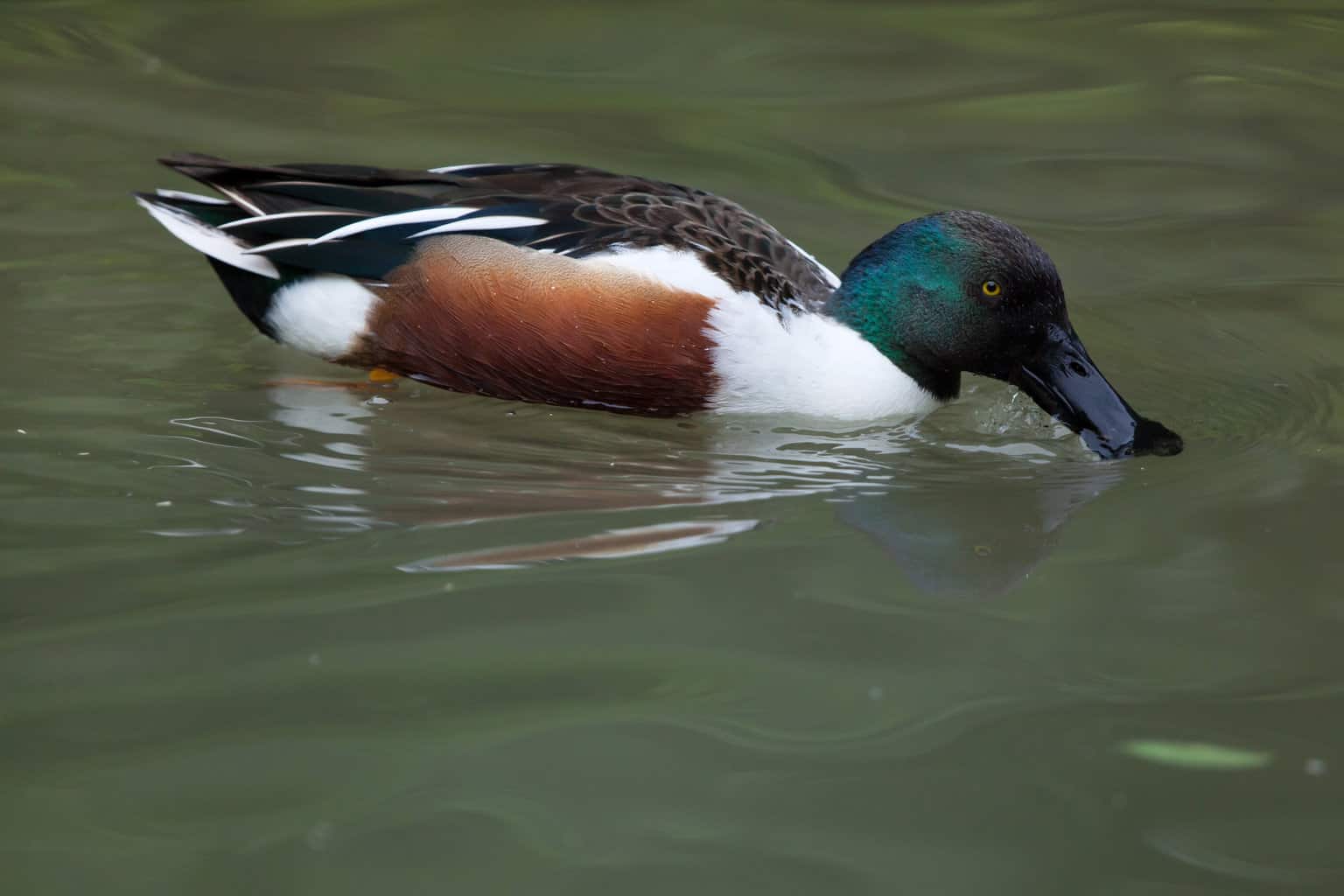
- Spatula clypeata
- Length: 17.3 – 20.1 in (44 – 51 cm)
- Weight: 14.1 – 28.9 oz (400 – 820 g)
- Wingspan: 27.2 – 33.1 in (69 – 84 cm)
A common sight in New Jersey in the winter months, northern shovelers are typically sighted between September and April. However, they have been spotted here throughout the year.
Look out for sociable groups of these breathtaking ducks in shallow bodies of stagnant water, where they use their bills to shovel up food from the water.
Males have green heads with distinctive large and spoon-shaped black bills. Their sides are russet red, their backs black, and their chests white. They also have blue wing patches. Females are speckled brown, with blue shoulder patches and large orange bills.
American Wigeon

- Mareca americana
- Length: 16.5 – 23.2 in (42 – 59 cm)
- Weight: 19.1 – 46.9 oz (540 – 1330 g)
- Wingspan: 33.1 in (84 cm)
You are most likely to encounter American wigeons in New Jersey during the winter. They typically arrive in the state in September and depart around April.
These ducks feed in wetlands and ponds, and near fields and grassland. They eat lots of vegetation but also sometimes insects or invertebrates.
The males have white caps and green side stripes on their heads and are otherwise grayish-brown. The females are brown with grayish heads. Both males and females have bills that are pale in color.
Northern Pintail
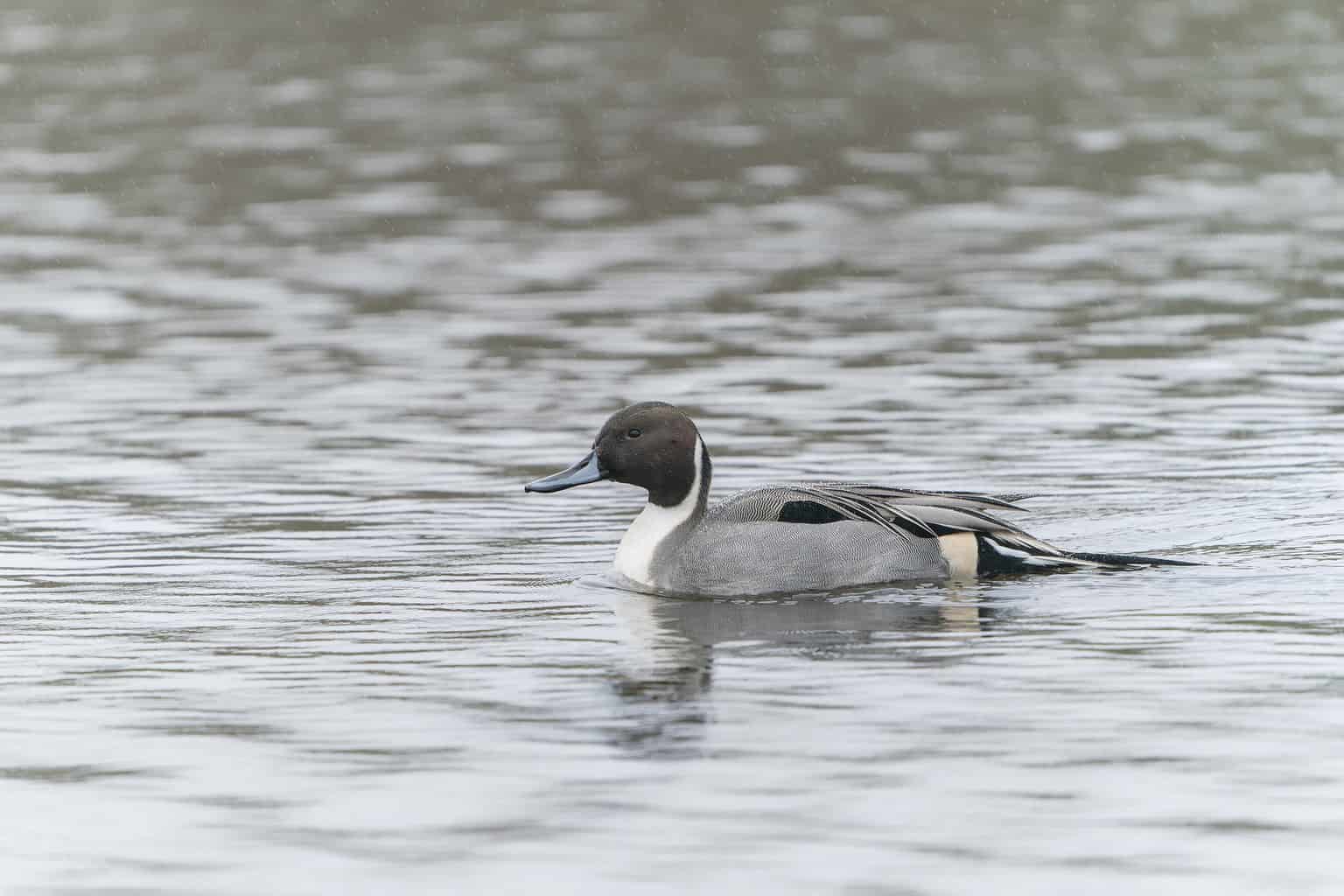
- Anas acuta
- Length: 20 – 26 in (51 – 66 cm)
- Weight: 36.33 oz (1030 g)
- Wingspan: 29 – 35 in (74 – 89 cm)
Northern pintails are a duck that can be seen in New Jersey year-round. However, you are most likely to see them between September and April, so look out for this species over the winter months for the best chance of seeing them.
These recognizable ducks are found alongside other ducks in open wetlands, marshes, prairies, and fields. But in the winter, they are most commonly seen along the coastline, in sheltered estuaries and salt marshes.
As the name suggests, these ducks are known for their long, pointed tails. Males have brown heads, white bodies, and a white stripe down their necks. Their backs are patterned in black, gray, and white. Females of these long-tailed ducks are brown with detailed scaled patterns.
Blue-Winged Teal
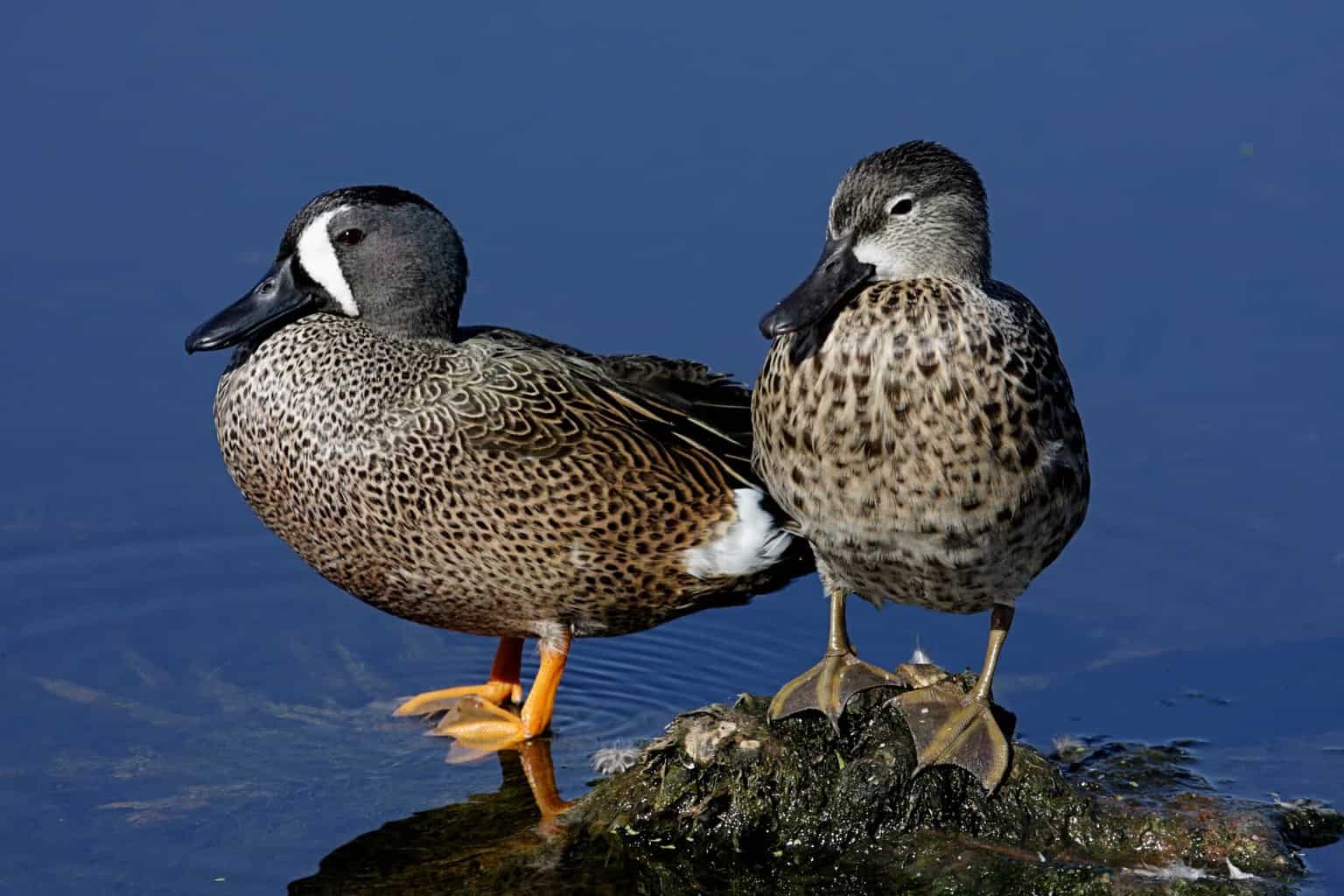
- Spatula discors
- Length: 15 – 17 in (38 – 43 cm)
- Weight: 19.18 oz (544 g)
- Wingspan: 23 – 31 in (58 – 79 cm)
The best times to look for blue-winged teal in New Jersey are during the migration periods. These birds are most commonly sighted in this state in spring and in fall during these periods.
You can expect to see these birds in calm coastal waters, or on lakes or ponds, making their way to or from breeding grounds in northern parklands and prairies.
These small and compact ducks have blue-gray heads with white crescents in front of their eyes, brown spotted bodies, and blue wing patches. Females are brown, with scaly patterns, and lack the white face markings of the males.
Eurasian Wigeon
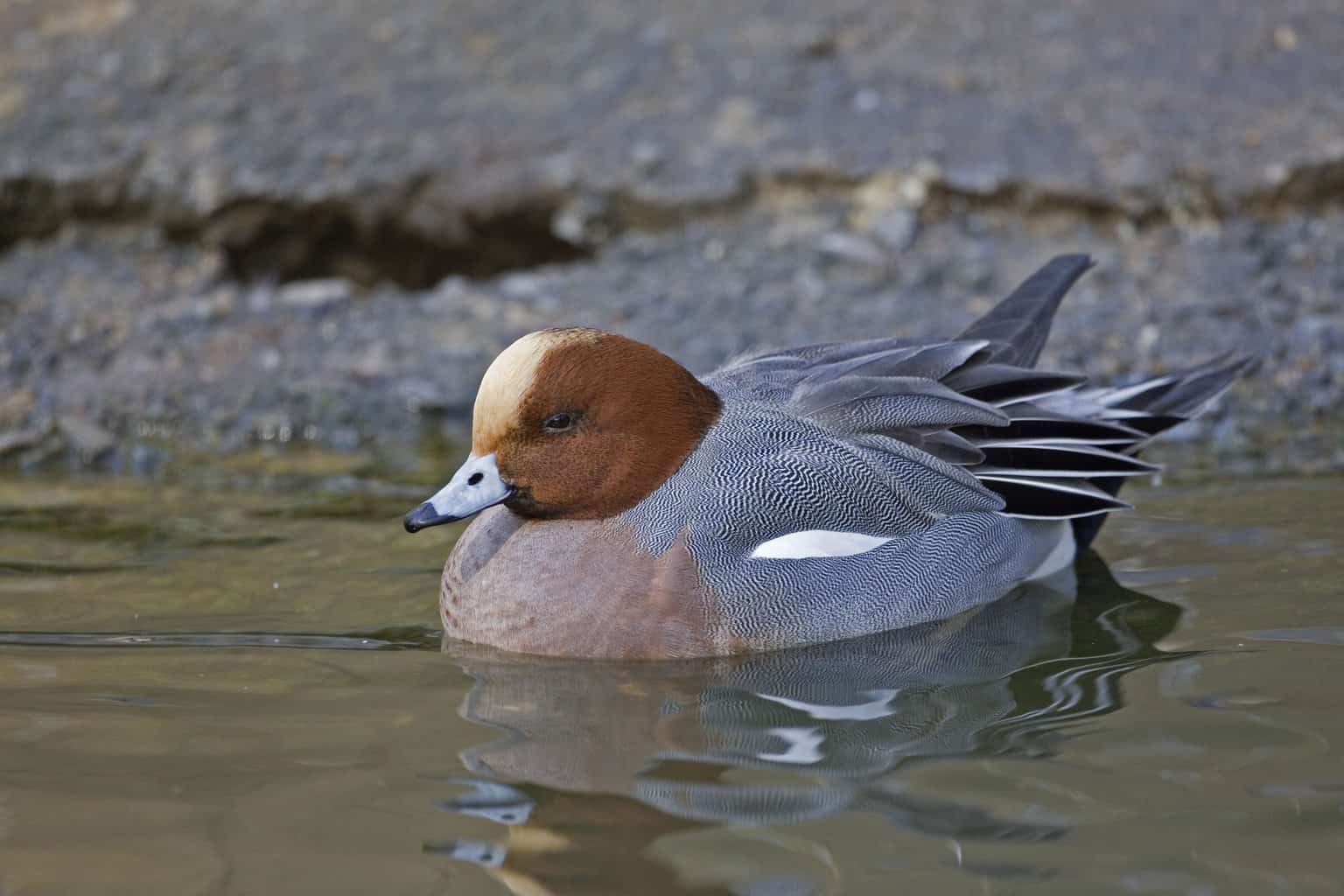
- Mareca penelope
- Length: 18 – 20 in (46 – 51 cm)
- Weight: 35.27 oz (1000 g)
- Wingspan: 30 – 32 in (76 – 81 cm)
Eurasian wigeons can be seen in New Jersey over the winter months. They typically arrive in September and leave around the middle of May.
Often feeding alongside other ducks, these birds can be seen on tidal flats, marshes, lakes, and ponds, eating aquatic vegetation.
The males have creamy patches on their cinnamon-hued heads, gray sides and backs, blue-gray bills, and pinkish breasts. Their wings have a green layer at the base, and white on the shoulder. The females are mostly patterned brown, with white beneath.
Buffleheads
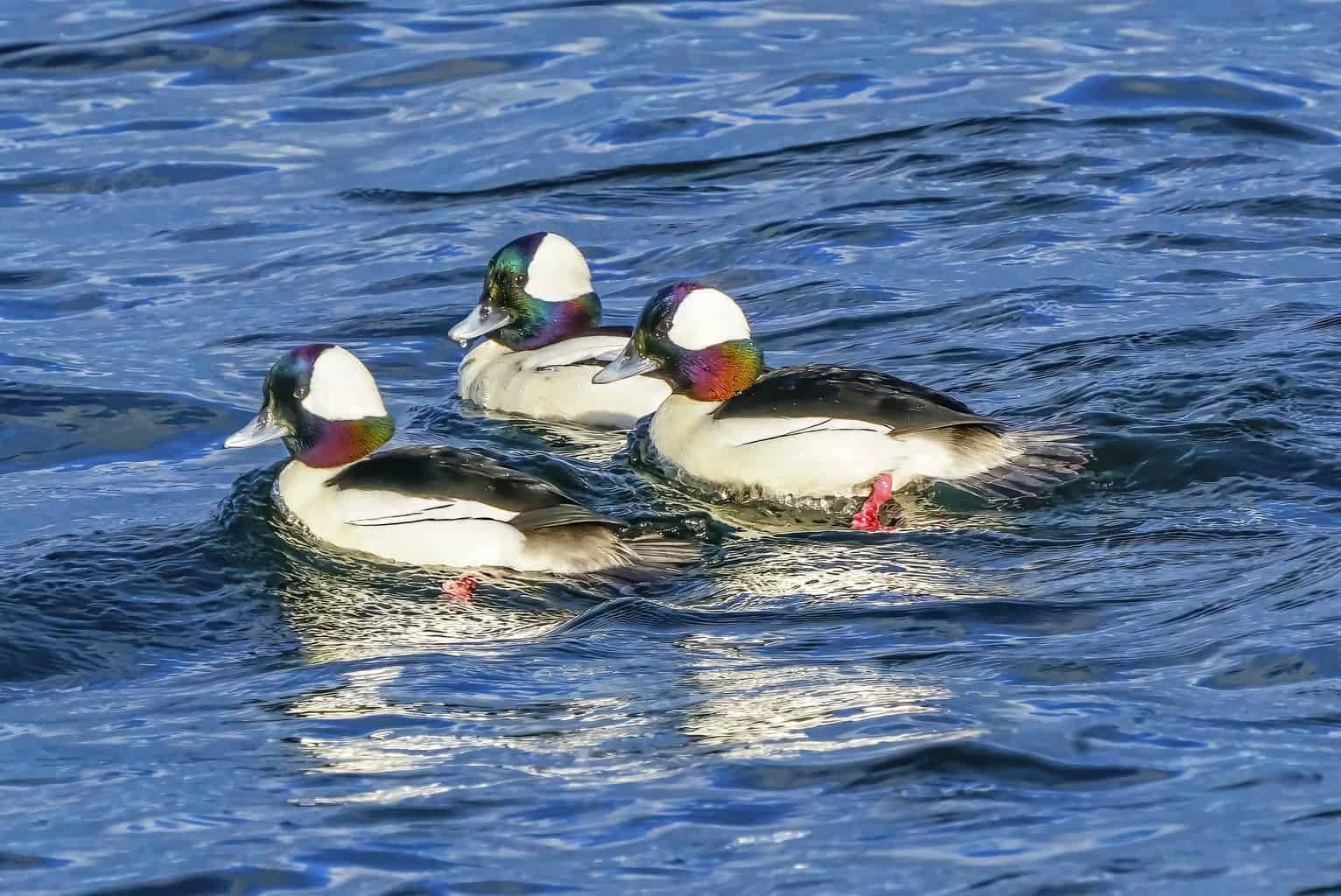
- Bucephala albeola
- Length: 13 – 16 in (33 – 41 cm)
- Weight: 21.16 oz (600 g)
- Wingspan: 20 – 24 in (51 – 61 cm)
Some buffleheads remain in New Jersey year-round. But they are most commonly seen between November and May, so it is best to look out for them over the winter months.
These expert diving ducks are found, in winter, spending time in protected coastal waters. You are most likely to see them in shallow bays diving for food that they eat underwater.
The males have bulbous heads with a large white patch behind the eyes, an iridescent green and purple crown, forehead, and neck. Their bodies are white below and black on top. Females share the bulbous head but otherwise look very different. They have dark brown or black heads with a white patch below each eye and are gray beneath and black on top.
Ring-necked Ducks
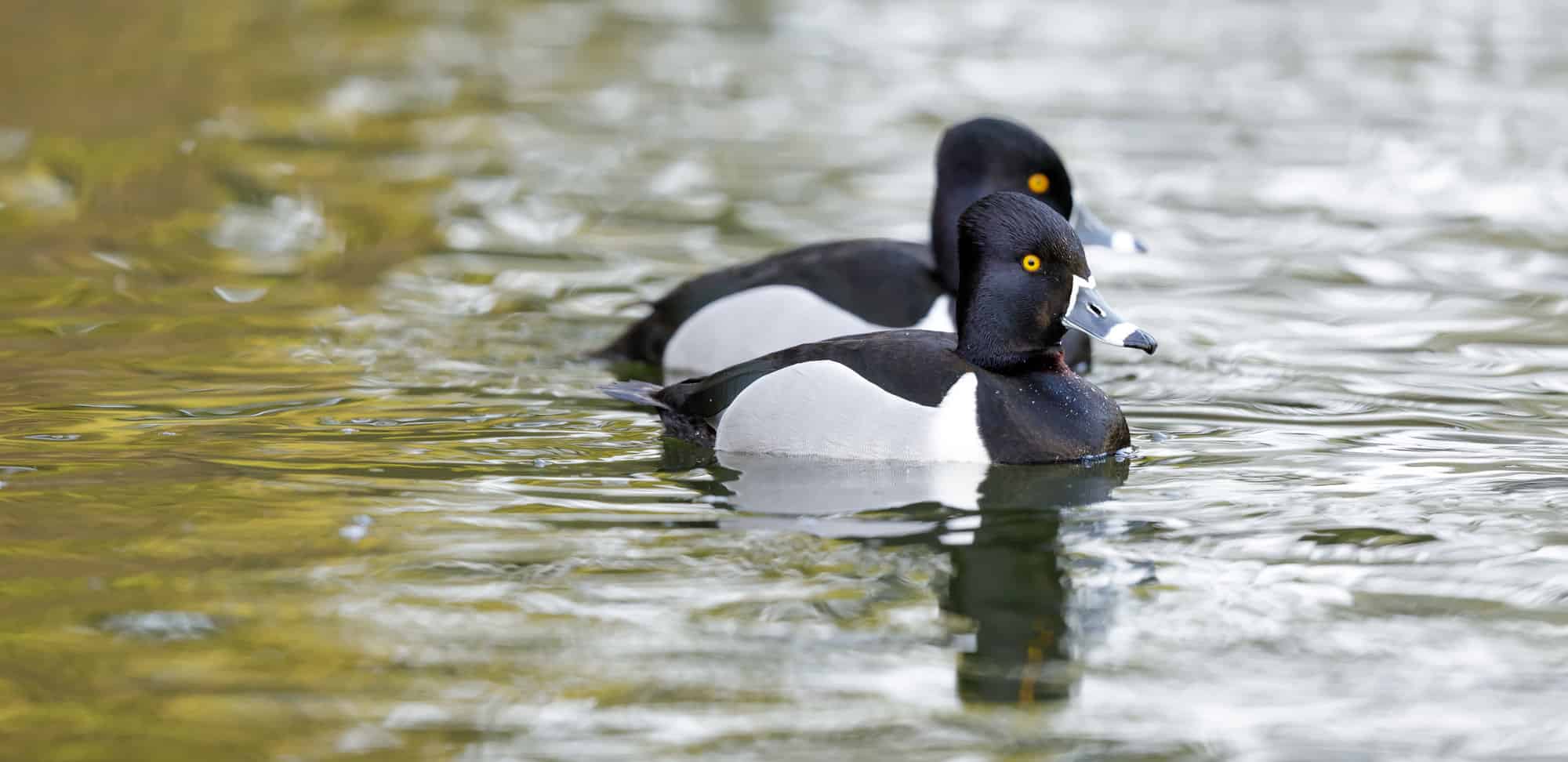
- Aythya collaris
- Length: 14 – 18 in (36 – 46 cm)
- Weight: 32.09 oz (909 g)
- Wingspan: 24 – 30 in (61 – 76 cm)
Ring-necked ducks are another duck most commonly seen in New Jersey during the winter months. You are most likely to spot them here between October and April. However, some individuals do remain here year-round.
Look out for these ducks in small, shallow ponds and along gentle rivers. They are diving ducks but most often forage for their favorite food on the water surface, only rarely diving below.
Males have black foreheads and gray, white-fringed bills with black tips. They have a cinnamon ring around the neck and their bodies are white below and black on top. Females are mostly brown, with gray faces and white eye rings.
Ruddy Ducks
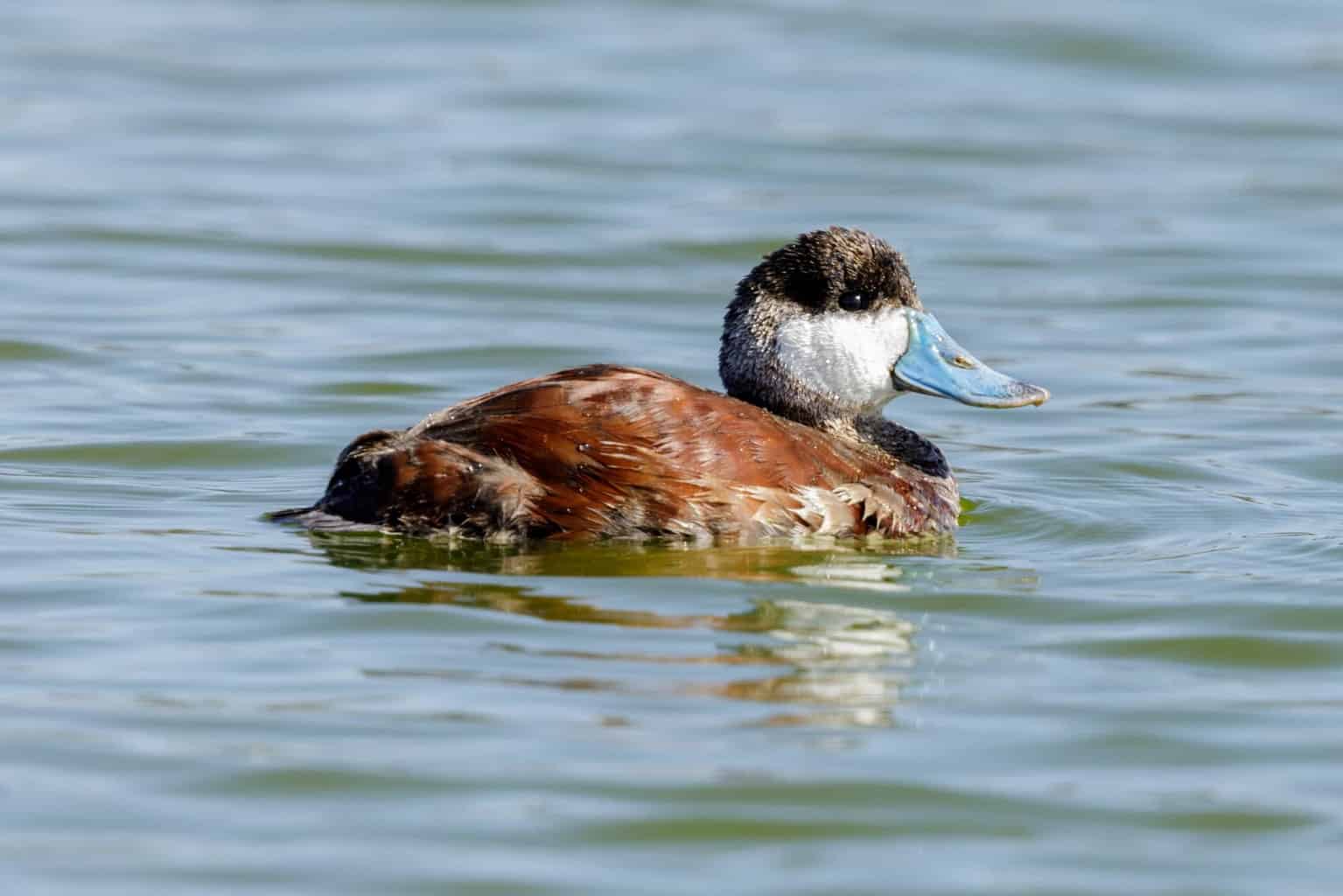
- Oxyura jamaicensis
- Length: 14 – 16 in (35.56 – 40.64 cm)
- Weight: 28.04 oz (795 g)
- Wingspan: 21 – 24 in (53 – 61 cm)
Again, ruddy ducks can remain here year-round but are most commonly seen in the winter. It is best to look out for them between October and March for the best chance of seeing them.
In summer, the ruddy duck enjoys a range of wetland or aquatic habitats and in winter, can be mostly found along the coastline here, in shallow coastal waters.
Male ruddy ducks take their name from the hue they turn during the breeding season. Outside that period they are a grayish hue. They have black caps, blue bills, and large white cheek patches. The females are broadly grayish too, like the non-breeding males, and they have brown caps and gray cheek patches with faint brown lines across them.
Lesser Scaup
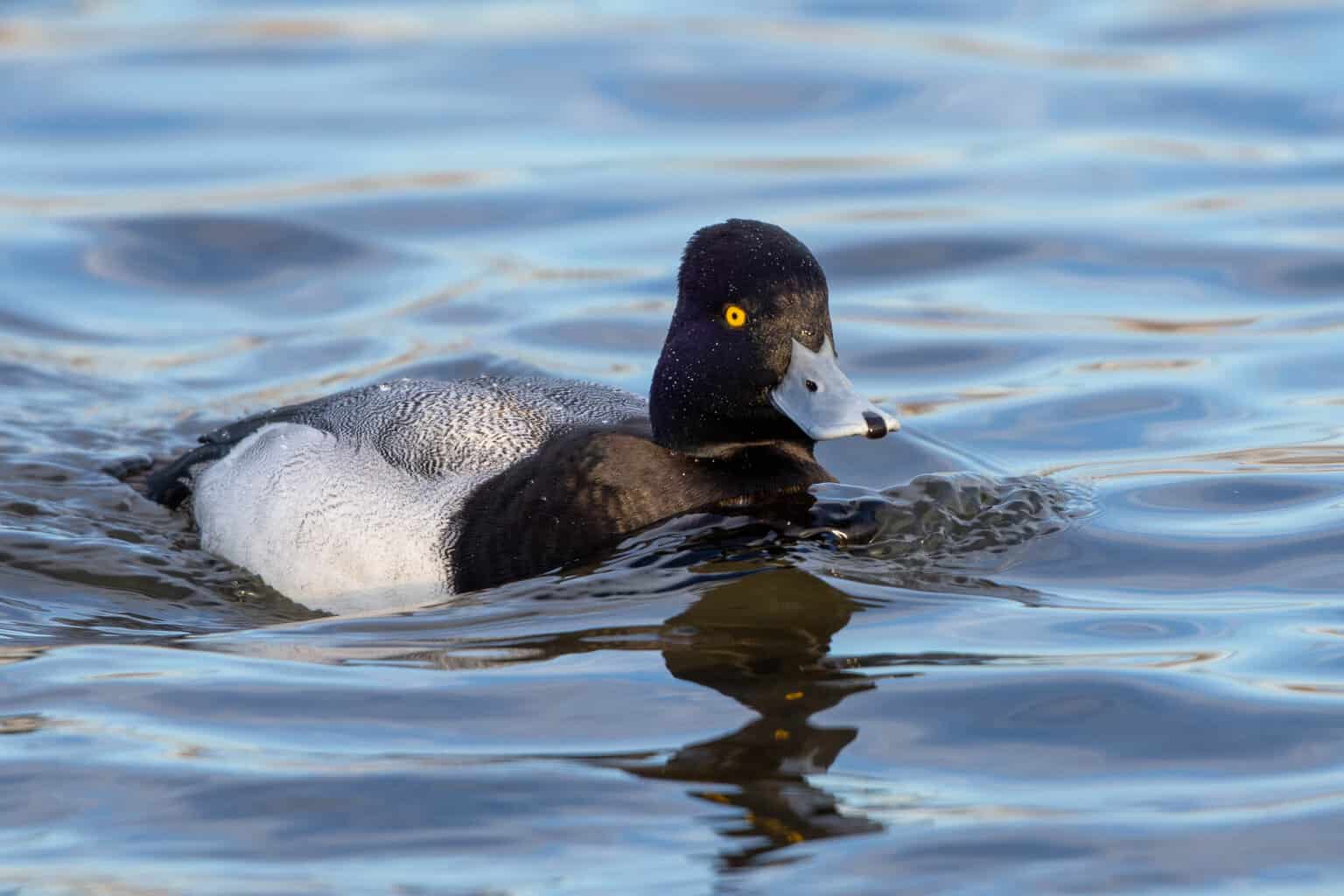
- Aythya affinis
- Length: 15 – 18 in (38 – 49 cm)
- Weight: 40.77 oz (1155 g)
- Wingspan: 24 – 33 in (61- 84 cm)
Lesser scaups are winter residents in New Jersey. They are typically seen here between October and April in this state.
Look out for these ducks in large groups on coastal waters, large lakes, or other bodies of water.
Lesser scaup males have purple-sheened black heads, chests and bottoms, white sides, and gray, patterned backs. They have tufts of hair on the top of their heads. Females have brown heads with white cheek patches. Their bodies are mostly brown, with gray sides, and they have no head tufts.
Greater Scaup
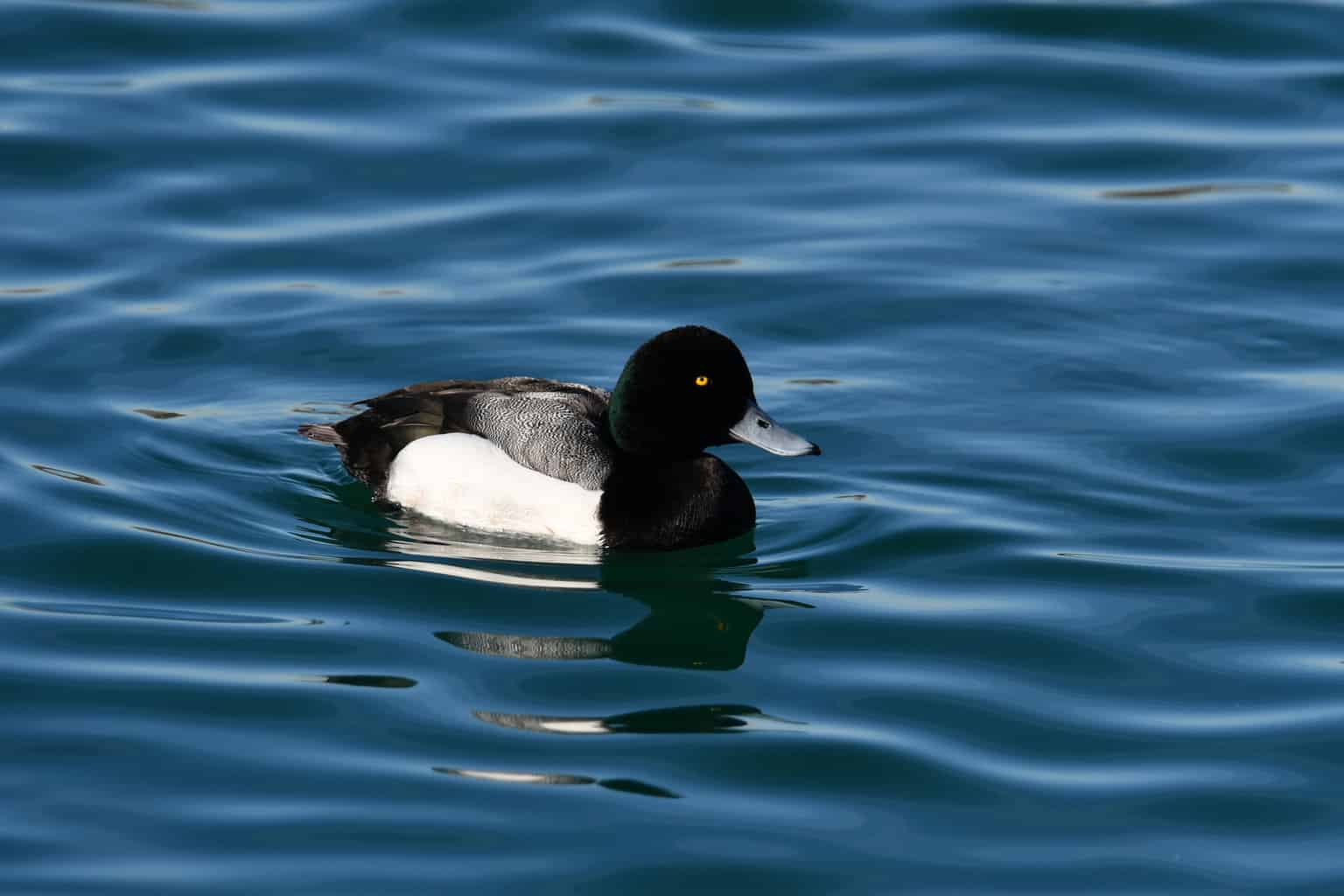
- Aythya marila
- Length: 15.3 – 22.1 in (39 – 56 cm)
- Weight: 25.6 – 48.0 oz (726 – 1360 g)
- Wingspan: 28.4 – 31.1 in (72 – 79 cm)
These ducks are also spotted in New Jersey between October and April.
They are easily confused with the above but have rounder heads, and males lack the distinctive tufts of the lesser scaup.
In winter, look for these birds in coastal waters and around the shoreline, forming large floating raft-like groups out at sea.
Canvasbacks
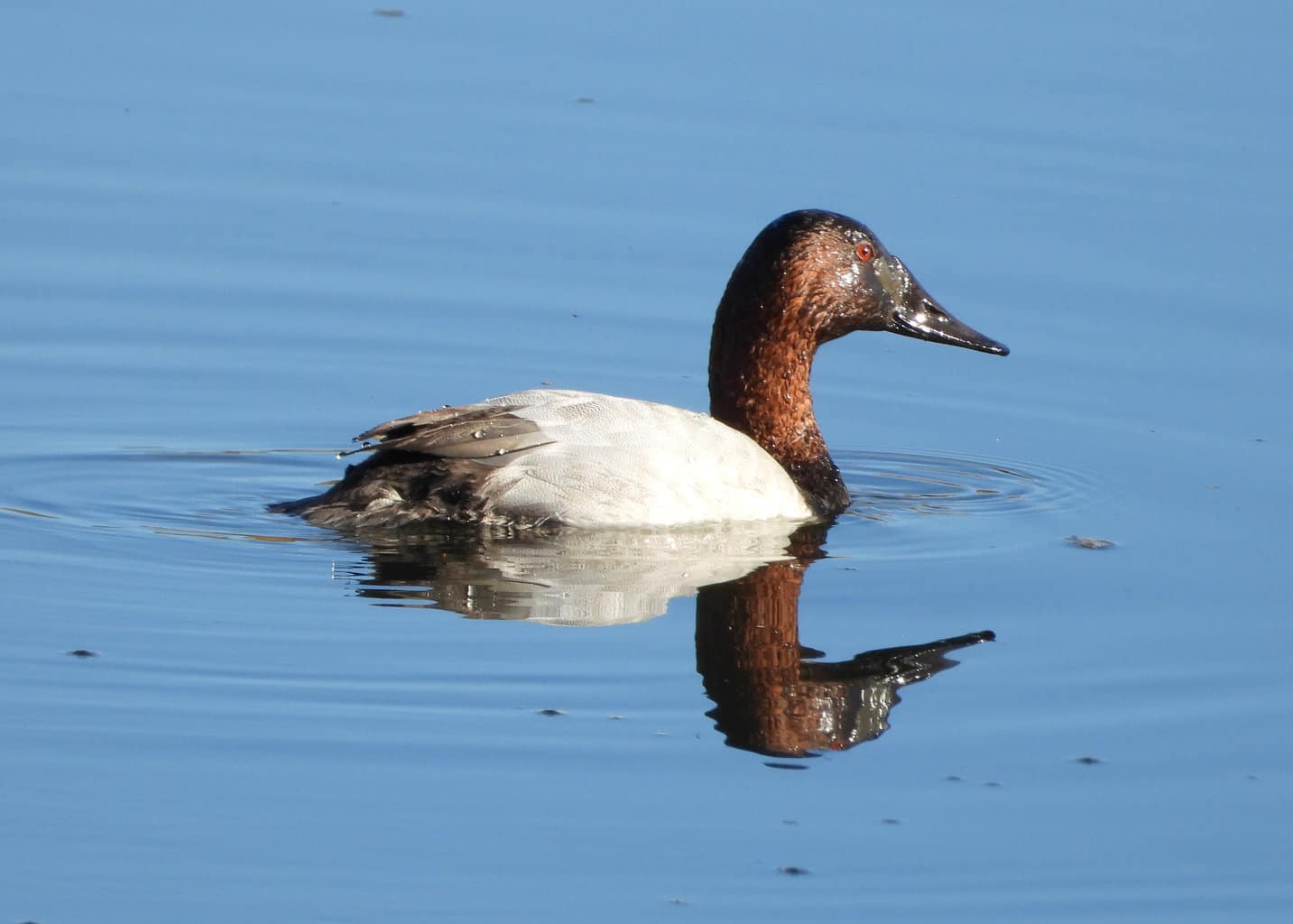
- Aythya valisineria
- Length: 19 – 24 in (48 – 61 cm)
- Weight: 58.48 oz (1657 g)
- Wingspan: 28 – 36 in (71 – 91 cm)
Canvasbacks spend the winter in New Jersey. They typically arrive here in October and depart around the middle of May.
Seek them out on coastal waters or open marshes, foraging for food out in the open water and diving down below.
Males have red eyes, and reddish-brown heads and throats. They have white or gray backs, and black chests and bottoms. Females are mostly patterned brown, with grayish bellies.
Redheads
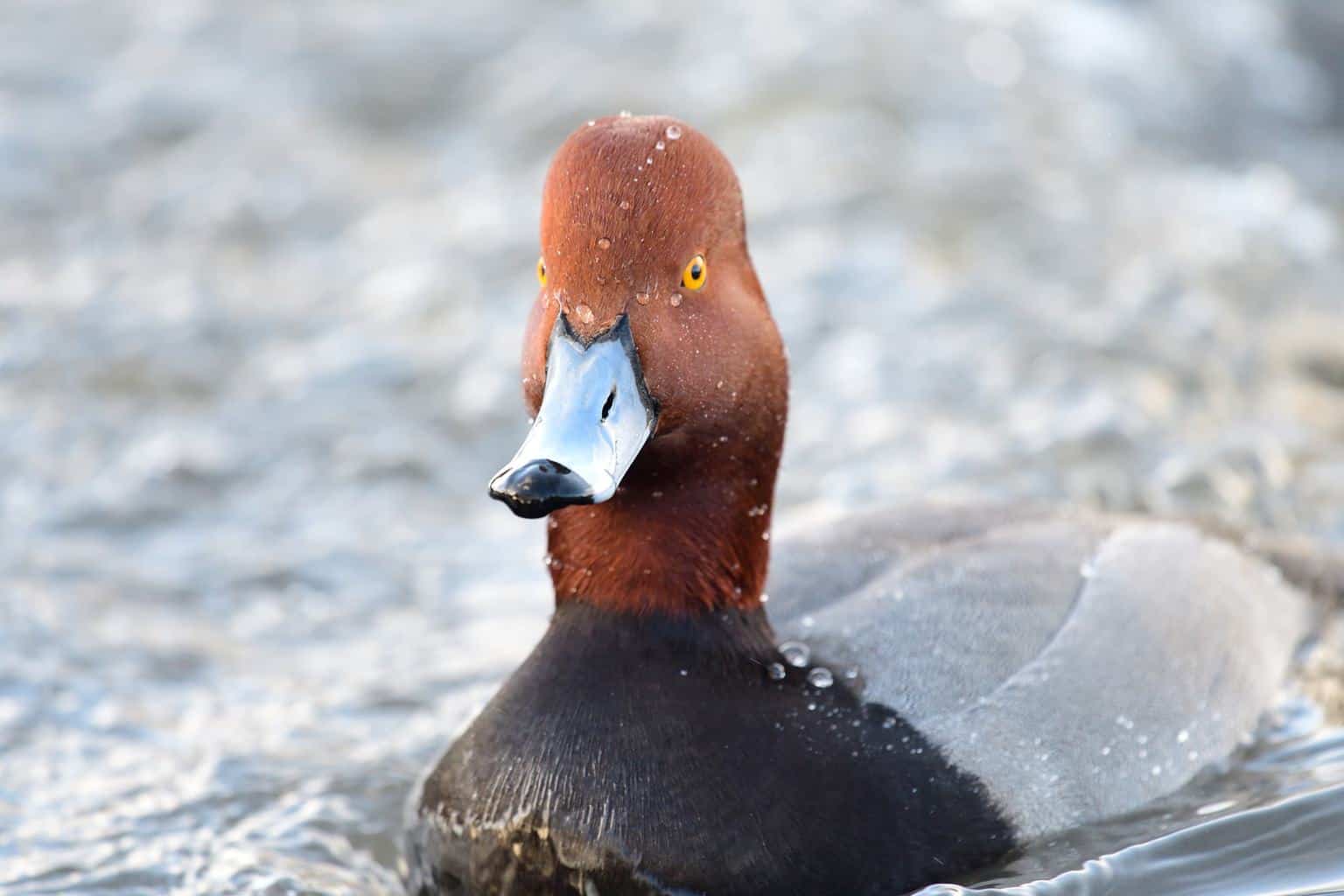
- Aythya americana
- Length: 18 – 22 in (46 – 56 cm)
- Weight: 43.03 oz (1219 g)
- Wingspan: 29 – 35 in (74 – 89 cm)
Redheads are another winter visitor to New Jersey. These ducks also typically arrive in October, though they will on the whole have departed a little earlier – usually in April.
These are also birds to look for along the coast shore in winter, in areas with calm, fairly shallow waters where they can dive and root out plants from below the surface.
Males have, as the name suggests, red heads. They also have black throats and mostly gray bodies. Female redheads are brown all over.
Hooded Merganser
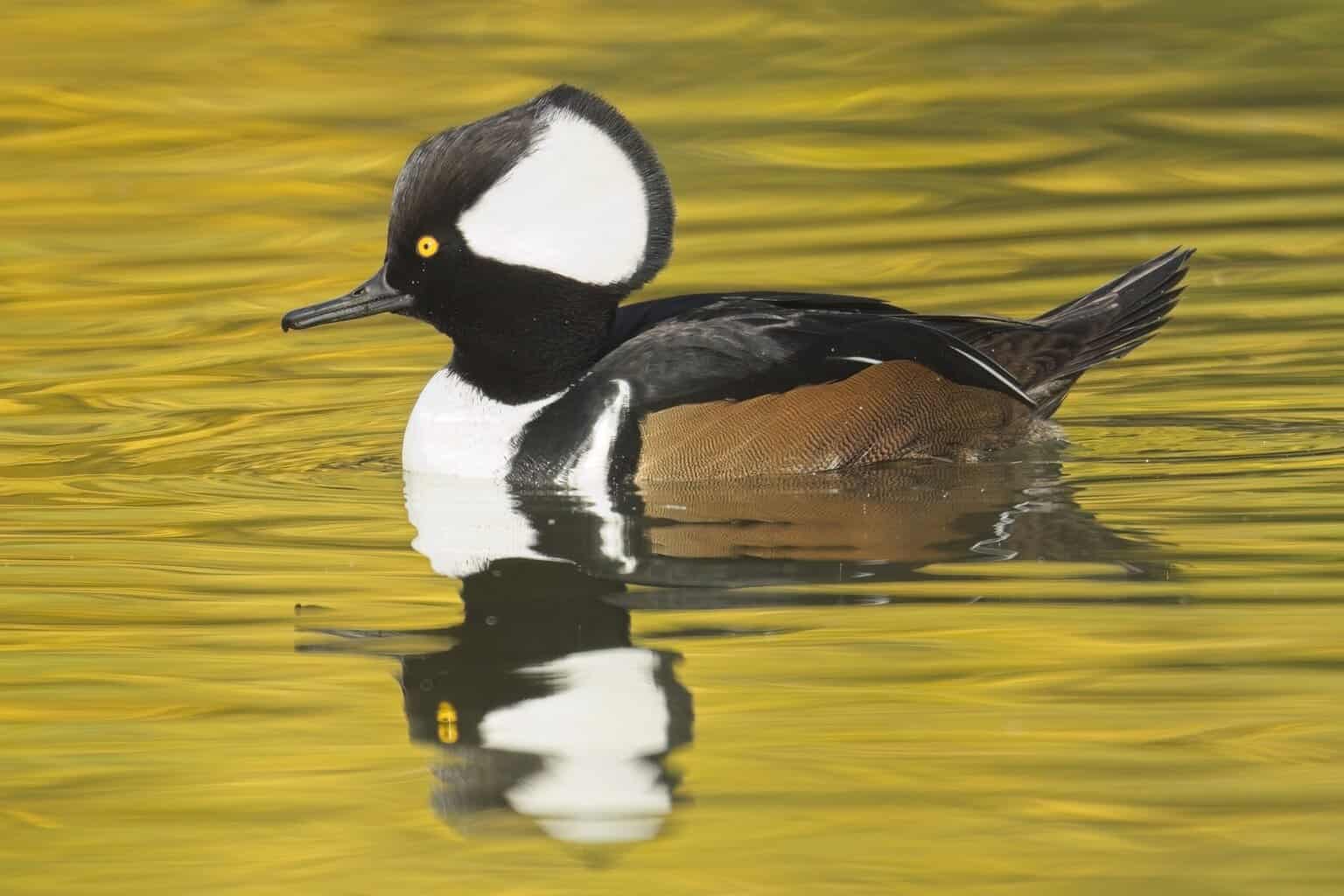
- Lophodytes cucullatus
- Length: 16 – 19 in (41 – 48 cm)
- Weight: 32.09 oz (909 g)
- Wingspan: 24 – 26 in (61 – 66 cm)
Hooded mergansers are another winter bird in New Jersey. They arrive in November and remain in the state until around April.
In winter, look for these ducks in inlets and calm saltwater bays where they can forage by diving under the water.
The males are notable for the white crests that they can raise and lower. Their heads are otherwise black and they have yellow eyes. Their bodies are black on top with white stripes towards the base, with cinnamon sides, and white chests with black bars. Females have red-brown crests and their bodies are brown-gray.
Common Merganser
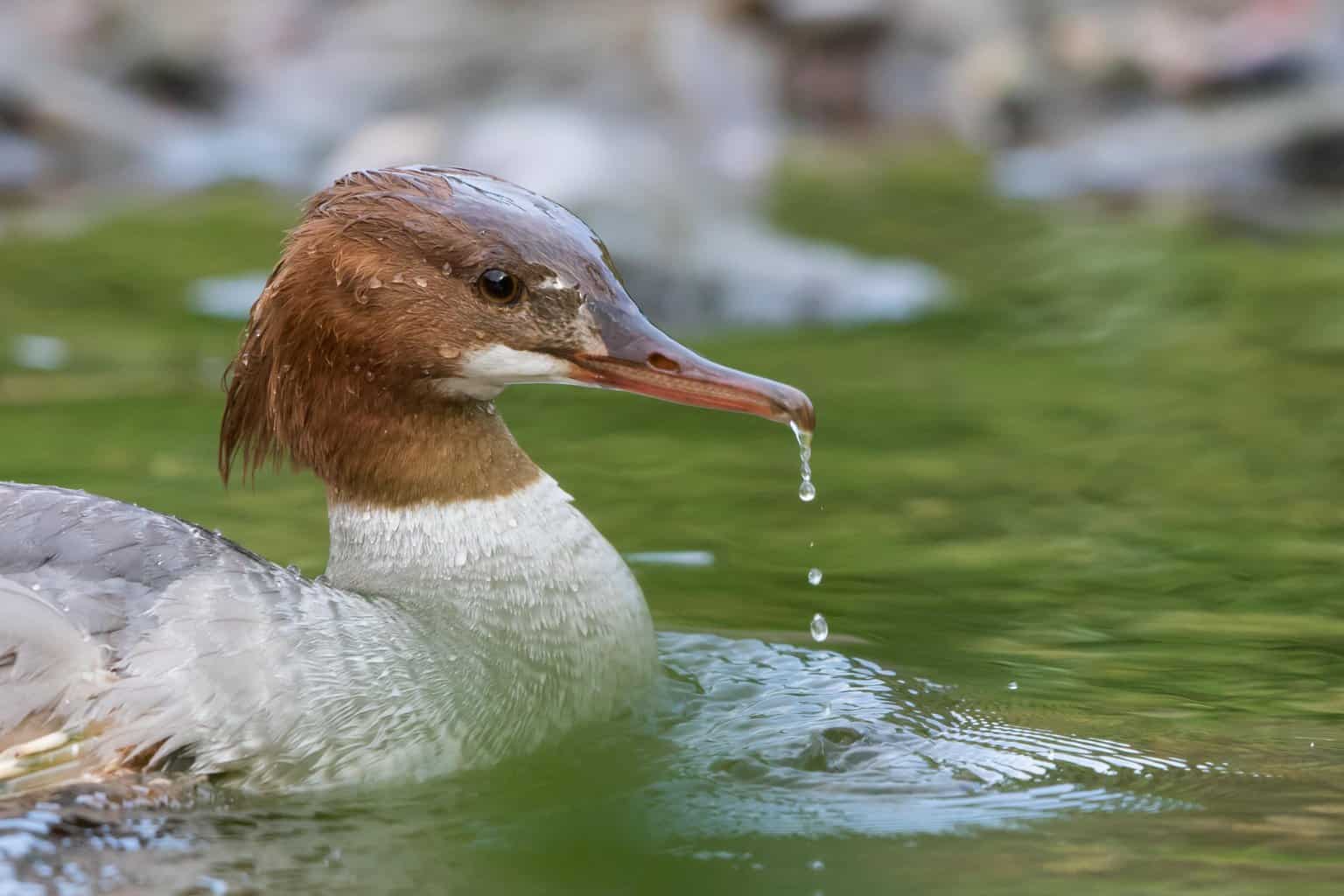
- Mergus merganser
- Length: 22 – 27 in (56 – 69 cm)
- Weight: 60.8 oz (1723 g)
- Wingspan: 31 – 37 in (79 – 94 cm)
You can see common merganser in New Jersey year-round. However, they are most numerous between December and March, so it is best to look out for them in the first months of the new year.
Males have green-sheened black heads, dark eyes, red bills, black backs, and white fronts. Females have a reddish-brown crest, gray backs, and white bellies. They also have red bills but also have white chin patches.
Red-breasted Merganser
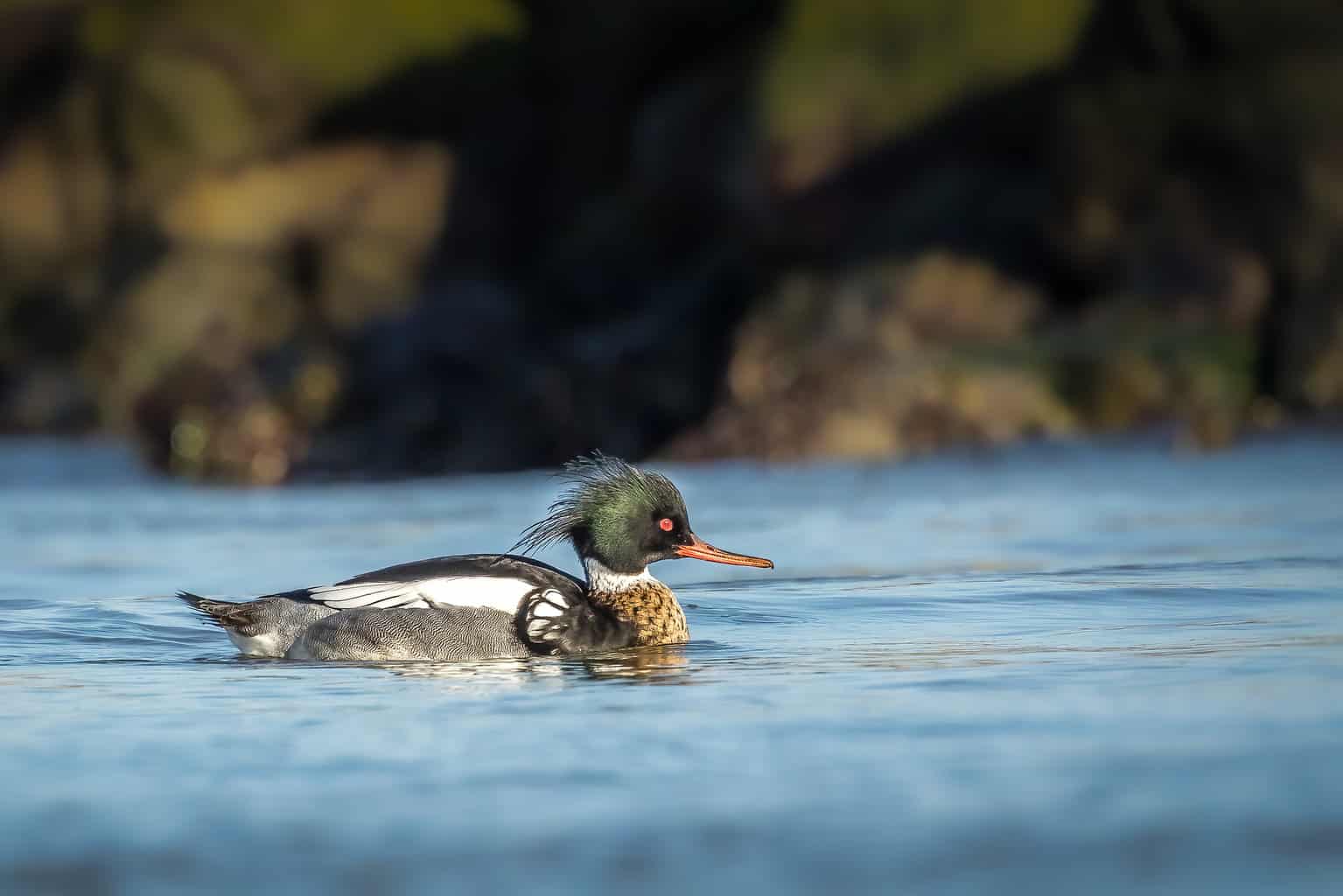
- Mergus serrator
- Length: 16 – 26 in (41 – 66 cm)
- Weight: 47.61 oz (1349 g)
- Wingspan: 31 – 35 in (79 – 89 cm)
Another duck to look out for in winter is the red-breasted merganser. These sea ducks are most commonly spotted here between the middle of October and May.
They can be found here in coastal waters and out in the ocean through the winter months.
Females have black, green-sheened heads, notable crests, dark red eyes, and orange bills. They have white rings around their necks, black and white backs, gray flanks, and mottled red-brown breasts.
Females and males not in breeding season have reddish-brown crests, white throats, and largely gray bodies.

